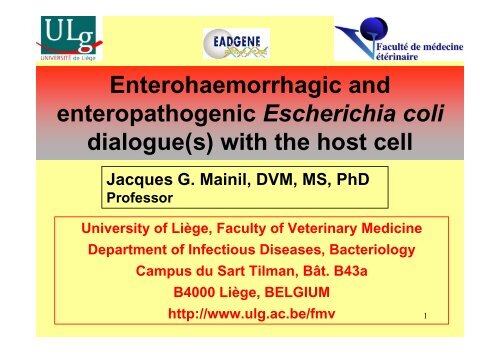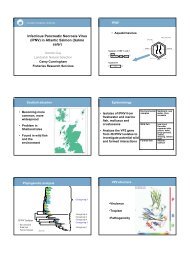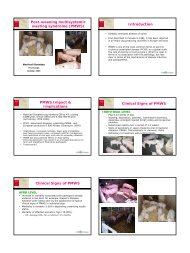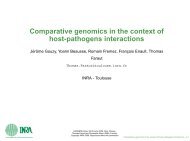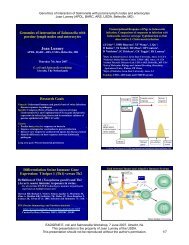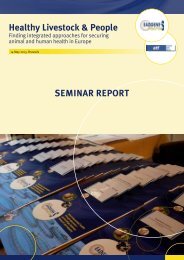Enterohaemorrhagic and enteropathogenic Escherichia ... - eadgene
Enterohaemorrhagic and enteropathogenic Escherichia ... - eadgene
Enterohaemorrhagic and enteropathogenic Escherichia ... - eadgene
You also want an ePaper? Increase the reach of your titles
YUMPU automatically turns print PDFs into web optimized ePapers that Google loves.
<strong>Enterohaemorrhagic</strong> <strong>and</strong><br />
<strong>enteropathogenic</strong> <strong>Escherichia</strong> coli<br />
dialogue(s) with the host cell<br />
Jacques G. Mainil, DVM, MS, PhD<br />
Professor<br />
University of Liège, Faculty of Veterinary Medicine<br />
Department of Infectious Diseases, Bacteriology<br />
Campus du Sart Tilman, Bât. B43a<br />
B4000 Liège, BELGIUM<br />
http://www.ulg.ac.be/fmv<br />
1
Content<br />
#1 The attaching/effacing lesion<br />
#2 The LEE-encoded effectors<br />
#3 The non-LEE-encoded effectors<br />
#4 Tccp: the missing link of EHEC<br />
#5 Discussion<br />
2
#1 The attaching/effacing lesion<br />
Stx +<br />
STEC/<br />
VTEC<br />
EHEC<br />
EPEC<br />
A/E +<br />
courtesy of H. W. Moon Mainil <strong>and</strong> Goffaux, 1997<br />
‣ Shiga/verocytotoxigenic <strong>Escherichia</strong> coli (STEC/VTEC)<br />
strains producing « only » Shiga toxins (Stx)<br />
‣ Enteropathogenic <strong>Escherichia</strong> coli (EPEC)<br />
strains producing « only » attaching/effacing lesion (A/E)<br />
‣ <strong>Enterohaemorrhagic</strong> <strong>Escherichia</strong> coli (EHEC)<br />
strains producing Stx <strong>and</strong> A/E lesion<br />
similar to O157:H7 E. coli causing haemorrhagic enterocolitis<br />
3
Content<br />
#1 The attaching/effacing lesion<br />
#2 The LEE-encoded effectors<br />
#3 The non-LEE-encoded effectors<br />
#4 Tccp: the missing link of EHEC<br />
#5 Discussion<br />
4
#2 The LEE-encoded effectors<br />
From Garmendia J. et al., Infect. Immun., 2005, 73, 2573-2585<br />
‣ ~50 genes <strong>and</strong> ORFs<br />
‣ 5 transcriptional units<br />
‣ Different insertion sites (selC, pheU, pheV, …)<br />
‣ Type III secretion machinery: esc/sep<br />
‣ Type-III-secreted translocator proteins: espA, espB, espD<br />
‣ Type-III translocated effectors: tir, espF, espG, espH, map, sepZ, ...<br />
5<br />
‣ Intimin adhesin: eae (type II-secreted outer membrane protein)
#2 The LEE-encoded effectors<br />
Kaper J.B., O’Brien A.D. E. coli O157:H7 <strong>and</strong> other Stx-producing E. coli, 1998, p175<br />
From Garmendia J. et al., Infect.<br />
Immun., 2005, 73, 2573-2585<br />
6
#2 The LEE-encoded effectors<br />
Hecht G.A. Microbial pathogenesis <strong>and</strong> the intestinal epithelial cell, 2003, p 429<br />
7
Content<br />
#1 The attaching/effacing lesion<br />
#2 The LEE-encoded effectors<br />
#3 The non-LEE-encoded effectors<br />
#4 Tccp: the missing link of EHEC<br />
#5 Discussion<br />
8
#3 The non-LEE-encoded effectors<br />
Name<br />
Role<br />
Gene<br />
EHEC/EPEC<br />
A/E lesion<br />
Cif<br />
Cyclomodulin<br />
Prophage<br />
EHEC/EPEC<br />
NleA/EspI<br />
unknown<br />
Prophage<br />
EHEC/EPEC<br />
NleC<br />
unknown<br />
Prophage<br />
EHEC/EPEC<br />
NleD<br />
Gut<br />
colonisation<br />
Prophage<br />
EHEC/EPEC<br />
TccP/EspFu<br />
Actin<br />
polymerisation<br />
Prophage<br />
EHEC<br />
+<br />
(tip of pedestal)<br />
EspJ<br />
unknown<br />
Prophage<br />
EHEC/EPEC<br />
EspG2<br />
Destruction of<br />
microtubule<br />
network<br />
Genomic<br />
isl<strong>and</strong><br />
EPEC<br />
NleB, NleE,<br />
NleF<br />
unknown<br />
Genomic<br />
isl<strong>and</strong>s<br />
EHEC/EPEC<br />
NleH<br />
unknown<br />
Chromosome<br />
EHEC/EPEC<br />
9
Content<br />
#1 The attaching/effacing lesion<br />
#2 The LEE-encoded effectors<br />
#3 The non-LEE-encoded effectors<br />
#4 Tccp: the missing link of EHEC<br />
#5 Discussion<br />
10
#4 Differences between EHEC <strong>and</strong> EPEC<br />
From Caron E. et al., Curr. Opinion.<br />
Microbiol., 2006, 9, 40-45<br />
Tccp interacts<br />
directly with N-WASP<br />
What of the<br />
interaction with Tir?<br />
From Cantarelli V.V. et al., Cellular Microbiol.,<br />
doi: 10.1111/j.1462-5822.2007.00913.x<br />
11
#4 Differences between EHEC <strong>and</strong> EPEC<br />
EPEC1: a novel pathway (ex-vivo assays)<br />
EPEC 1<br />
EPEC 2 &<br />
O157 EHEC<br />
non-O157 EHEC EPEC 1<br />
From Schüller S. et al., Cellular Microbiol., 2007, 9, 1352-1364<br />
12
#3 The non-LEE-encoded effectors<br />
? The actual role of EHEC/EPEC effectors ¿<br />
In vitro on cell cultures: origin of the cells<br />
(species, organ)<br />
Ex-vivo on IVOC, ligated loops: animal species,<br />
intestinal segment<br />
In vivo infection models: animal species, age<br />
Extrapolation to humans<br />
13
Content<br />
#1 The attaching/effacing lesion<br />
#2 The LEE-encoded effectors<br />
#3 The non-LEE-encoded effectors<br />
#4 Tccp: the missing link of EHEC<br />
#5 Discussion<br />
14
#5 Discussion<br />
Host specificity of EHEC<br />
‣ Diarrhoea, HC <strong>and</strong> HUS in humans<br />
O26, O103, O111, O118, O145, O156, O157, …<br />
‣ Diarrhoea in young calves<br />
O5, O26, O111, O118, …<br />
‣ Healthy carriage in ruminants<br />
O103, O145, O156, O157, …<br />
O5, O26, O111, O118, …<br />
O49, O72, O177, …<br />
15
Ruminants<br />
#5 Discussion<br />
Host specificity of EHEC<br />
? Direct contacts ?<br />
Meat, milk<br />
Humans<br />
Vegetables,<br />
fruits<br />
Faeces<br />
Swimming<br />
waters<br />
Intestinal content, faeces<br />
Dung, manure<br />
Soils<br />
Waters<br />
Drinking water<br />
16
Origin<br />
Calves<br />
(Diarrhea)<br />
Cattle<br />
(Healthy)<br />
Sheep/Goat<br />
(Healthy)<br />
Foods<br />
Properties<br />
Humans<br />
(HC, HUS, TTP)<br />
Serotytpes<br />
#5 Discussion<br />
Comparison of human, ruminant <strong>and</strong> food EHEC<br />
Stx<br />
profiles<br />
Stx1<br />
Stx1/Stx2<br />
Stx2<br />
Stx variants<br />
O26, O49,<br />
O103, O111,<br />
O118, O145,<br />
Stx1<br />
Stx1/Stx2<br />
Stx2<br />
Stx2<br />
Stx2c<br />
(Stx2d)<br />
eae β/tir β/esp β<br />
eae γ2/tir α/esp α<br />
eae γ1/tir γ1/esp γ1<br />
O156, O157,<br />
eae ε/tir β/esp β<br />
…<br />
O5, O26, Though Stx1 there Not relevant exist eae β/tir different β/esp β<br />
O111, O118,<br />
eae γ2/tir α/esp α<br />
…<br />
O5, O26,<br />
O103, O111,<br />
O118, O145,<br />
O157, …<br />
Stx1<br />
Stx1/Stx2<br />
Stx2<br />
Stx2<br />
Stx2c<br />
eae β/tir β/esp β<br />
eae γ2/tir α/esp α<br />
eae γ1/tir γ1/esp γ1<br />
eae ε/tir β/esp β<br />
O26, O49,<br />
O52, O111,<br />
O156, O177,<br />
…<br />
Stx1<br />
(Stx2)<br />
Stx1c<br />
Stx2d<br />
eae β/tir β/esp β<br />
eae γ2/tir α/esp α<br />
eae γ1/tir γ1/esp γ1<br />
Very many<br />
Not reported<br />
Rarely<br />
reported<br />
(Stx2, Stx2c)<br />
LEE profiles<br />
Ent-Hly &<br />
pEHEC<br />
67 %<br />
(50-100%)<br />
Variable<br />
evolutionnary lineages within some<br />
serotypes, properties of human,<br />
ruminant <strong>and</strong> food EHEC are more<br />
serotype-specific than host-specific<br />
50 %<br />
(25-100%)<br />
25 %<br />
(?)<br />
Not<br />
reported
#5 Discussion<br />
Comparison of human <strong>and</strong> ruminant EHEC:<br />
the non-LEE-encoded effectors<br />
Comparison of human <strong>and</strong> ruminant EHEC:<br />
the response of human <strong>and</strong> bovine<br />
enterocytes in vitro <strong>and</strong> ex-vivo


